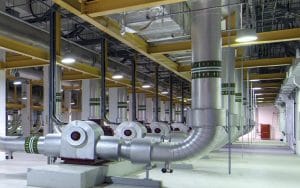 There are many different factors that have contribute to the push for greener and more eco-friendly business practices over the last few decades. Consumers have grown more conscious of their own impacts on the environment, as well as those of the companies they buy products from, and now demand higher levels of responsibility from anyone they do business with. Regulations, higher costs of energy and operations, and much more have been equally influential, and today, company’s find value in any successful measure that helps them become more eco-friendly. This has been felt prominently in the realm of electrical thermal management, where heat exchangers have largely transformed the principles of thermal management using more innovative heat transfer methods.
There are many different factors that have contribute to the push for greener and more eco-friendly business practices over the last few decades. Consumers have grown more conscious of their own impacts on the environment, as well as those of the companies they buy products from, and now demand higher levels of responsibility from anyone they do business with. Regulations, higher costs of energy and operations, and much more have been equally influential, and today, company’s find value in any successful measure that helps them become more eco-friendly. This has been felt prominently in the realm of electrical thermal management, where heat exchangers have largely transformed the principles of thermal management using more innovative heat transfer methods.
Increasingly larger roles of thermal management
The need for more efficient thermal management solutions isn’t new, but previously, the costs and burdens associated with it were necessary to shoulder. Air conditioning and air compression units were essential to keeping electrical enclosures from overheating, and companies had few (if any) affordable alternative options to turn to. However, technology and the roles of thermal management have expanded beyond what traditional solutions are able to keep up with, and the innovation of solutions like heat exchangers made the burdens of older solutions less necessary to carry. In fact, the more streamlined methods of heat exchangers made it possible for companies to significantly enhance their operations without having to invest in greater energy expenditures or technical expertise.
The environmental impacts of traditional solutions
The large costs associated with older forms of electrical cooling stem from the amounts of energy they use, and from the amount of maintenance and frequency of repairs they require. The goal of such solutions is to utilize chilled air to maintain cooler temperatures within electrical enclosures. This stops the enclosure and the electrical components within it from overheating; however, it also requires the generation and circulation of chilled air. In addition to the use of large amounts of energy, such processes also typically involve the use of potentially harmful chemicals that could impact the surrounding environment.
Greener and more eco-friendly cooling methods
The ways in which heat exchangers approach electrical cooling differ greatly from more traditional solutions, and they’re the foundation of how they provide more eco-friendly cooling. Rather than utilizing chilled air to control the temperatures inside of electrical enclosures, heat exchangers stop the temperatures from rising at all by constantly transferring electrical waste heat. This only requires an eco-friendly cooling fluid that can flow continuously through the heat exchanger, and an advanced design (such as heat pipes or cold plates) for the fluid to efficiently transfer waste heat through.
For more information about how companies are using heat exchangers to make operations eco-friendly, call Noren Thermal Solutions in Taylor, TX, at 866-936-6736.







